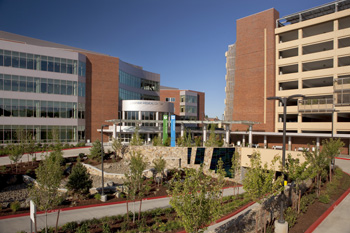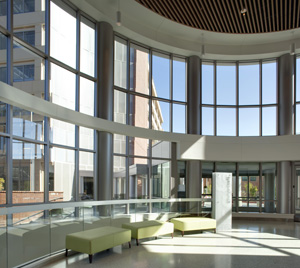Kaiser Permanente’s Rame Hemstreet Discusses LEED Gold Commitment
 OAKLAND, Calif. — On May 22, Kaiser Permanente announced it will seek LEED Gold certification for new construction of hospitals and other major projects over $10 million. The organization’s first hospital to earn LEED Gold status will be the Kaiser Permanente Westside Medical Center, which is scheduled to open in August in Hillsboro, Ore. The 126-bed hospital is the organization’s 38th hospital.
OAKLAND, Calif. — On May 22, Kaiser Permanente announced it will seek LEED Gold certification for new construction of hospitals and other major projects over $10 million. The organization’s first hospital to earn LEED Gold status will be the Kaiser Permanente Westside Medical Center, which is scheduled to open in August in Hillsboro, Ore. The 126-bed hospital is the organization’s 38th hospital.
With plans to spend about $30 billion in construction over the next 10 years, Kaiser Permanente estimates that the LEED Gold commitment will affect 15 million square feet of real estate or more than 100 buildings. HealthCare Construction + Operations News speaks with Kaiser Permanente’s Chief Energy Officer Rame Hemstreet about the LEED Gold commitment and what it means for the organization, as well as the health care industry as a whole.
Q: What are the key benefits for Kaiser Permanente when it comes to deciding to build LEED Gold?
Hemstreet: It was a natural progression for us. We’ve been a leader in sustainable design and construction for a while and even helped write the Green Guide for Health Care [prior to the new LEED for Health Care or LEED-HC rating system]. We thought we’d demonstrate that if you took sustainability into account from the initial phases of the project that you can build a sustainable facility with little or no additional costs and reap long-term benefits. There is a health component to sustainable design that will assist us in our mission of health care and also make the building more productive for the people that work there.
Q: What do you think about the LEED-HC standard and are you looking to reach those requirements as well?
 Hemstreet: For our hospitals and large ambulatory service centers, yes. Of course, we also build a lot of medical office buildings, and we think for that LEED for New Construction would be more appropriate. LEED Gold will apply to all new footprint over $10 million, but whether it’s it LEED-HC or LEED for New Construction will depend on its purpose.
Hemstreet: For our hospitals and large ambulatory service centers, yes. Of course, we also build a lot of medical office buildings, and we think for that LEED for New Construction would be more appropriate. LEED Gold will apply to all new footprint over $10 million, but whether it’s it LEED-HC or LEED for New Construction will depend on its purpose.
Q: Are you actually seeking LEED certification for each project or just building them to those standards?
Hemstreet: Certification. I feel that “certifiable” is like saying I can run the 100-yard dash in 10 seconds, but I’ve never actually timed myself.
Q: How has the building of the Westside Medical Center influenced your decision to build LEED Gold?
Hemstreet: Westside was proof of the concept that we could do it. We tried to define the costs attributed to LEED certification and it was less than 1 percent of the total costs; those attributes would actually have a hard economic payback five times that over the life of the building. Then, there are the noneconomic benefits or difficult-to-quantify economic benefits, such as increased productivity and an enhanced healing environment. There’s also a brand aspect; obviously, having a LEED Gold plaque enhances the brand and long-term value of that building.
Q: How do you think Kaiser Permanente’s commitment to building green will affect the overall health care construction industry?
Hemstreet: Already, we’re not alone. The last count we had was that there are 28 hospitals across the country that have met LEED Gold/Platinum. As one of the largest real estate owners in the health care industry, this will enhance that trend and perhaps accelerate that trend, but it’s occurring regardless. Across the industry, we’re recognizing the hard and soft benefits of sustainable construction.
Q: What has the community’s reaction to the commitment been, and how do you think it will affect the health care industry as a whole?
Hemstreet: The reaction of the community is very positive. That was one of the drivers for Westside being the LEED Gold pilot because the local community is very supportive. Increasingly communities are demanding it. As far as the health care industry, I hope we can demonstrate to our members that are cared for at our hospitals that a high-performing building can reduce the hospital stay time of members. There’s anecdotal evidence along those lines, but I think as we develop an inventory of these high-performing buildings, we can demonstrate the health care and productivity improvements that they provide us.
Q: What Kaiser Permanente projects are currently in the works?
Hemstreet: We have a number [of projects] in design (and some that are actually starting construction) that are targeted for LEED Gold — about half a dozen actually. There were some other buildings underway prior to our policy that will not necessarily reach that goal but will be LEED Silver opening over the next year to 18 months. Following that, over the next decade, there will be up to 100 LEED Gold buildings.
Q: What do you think this commitment means for the future of Kaiser?
Hemstreet: I think it means the built environment will contribute to high quality affordable health care for members. I’m convinced that the built environment is one aspect of health care that occurs within those four walls and a ceiling and that sustainable design can also help make us more affordable by reducing long-term operating costs. We made a commitment to a 35 percent greenhouse reduction goal by 2020 compared to our 2008 baseline. That’s not relative to our size considering we’ll be growing our footprint in the course of those 12 years, so the reduction will be greater than that. In the short term, the more important aspect is reducing energy demand in our existing buildings and finding renewable on-site and off-site sources of energy. In the longer term, the more sustainable and the more energy efficient we construct our new buildings and the more on-site renewals we incorporate into those new buildings, the smaller our carbon footprint will be.
It is our expectation that our design and partners and consultants will help us get to LEED Gold with no additional first costs. We think this should be the standard in the building industry, and not something we pay a premium for.
